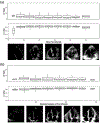Video-based AI for beat-to-beat assessment of cardiac function
- PMID: 32269341
- PMCID: PMC8979576
- DOI: 10.1038/s41586-020-2145-8
Video-based AI for beat-to-beat assessment of cardiac function
Abstract
Accurate assessment of cardiac function is crucial for the diagnosis of cardiovascular disease1, screening for cardiotoxicity2 and decisions regarding the clinical management of patients with a critical illness3. However, human assessment of cardiac function focuses on a limited sampling of cardiac cycles and has considerable inter-observer variability despite years of training4,5. Here, to overcome this challenge, we present a video-based deep learning algorithm-EchoNet-Dynamic-that surpasses the performance of human experts in the critical tasks of segmenting the left ventricle, estimating ejection fraction and assessing cardiomyopathy. Trained on echocardiogram videos, our model accurately segments the left ventricle with a Dice similarity coefficient of 0.92, predicts ejection fraction with a mean absolute error of 4.1% and reliably classifies heart failure with reduced ejection fraction (area under the curve of 0.97). In an external dataset from another healthcare system, EchoNet-Dynamic predicts the ejection fraction with a mean absolute error of 6.0% and classifies heart failure with reduced ejection fraction with an area under the curve of 0.96. Prospective evaluation with repeated human measurements confirms that the model has variance that is comparable to or less than that of human experts. By leveraging information across multiple cardiac cycles, our model can rapidly identify subtle changes in ejection fraction, is more reproducible than human evaluation and lays the foundation for precise diagnosis of cardiovascular disease in real time. As a resource to promote further innovation, we also make publicly available a large dataset of 10,030 annotated echocardiogram videos.
Figures









Comment in
-
AI tracks a beating heart's function over time.Nature. 2020 Apr;580(7802):192-194. doi: 10.1038/d41586-020-00819-6. Nature. 2020. PMID: 32214236 No abstract available.
-
Estimating ejection fraction by video-based AI.Nat Rev Cardiol. 2020 Jun;17(6):320. doi: 10.1038/s41569-020-0375-y. Nat Rev Cardiol. 2020. PMID: 32265543 No abstract available.
References
-
- Farsalinos KE et al. Head-to-Head Comparison of Global Longitudinal Strain Measurements among Nine Different Vendors: The EACVI/ASE Inter-Vendor Comparison Study. J. Am. Soc. Echocardiogr 28, 1171–1181, e2 (2015). - PubMed
-
- Lang RM et al. Recommendations for cardiac chamber quantification by echocardiography in adults: an update from the American Society of Echocardiography and the European Association of Cardiovascular Imaging. Eur. Heart J. Cardiovasc. Imaging 16, 233–270 (2015). - PubMed
Methods References
-
- Kay W et al. The Kinetics Human Action Video Dataset. arXiv [cs.CV] (2017).
-
- Tran D et al. A Closer Look at Spatiotemporal Convolutions for Action Recognition. 2018 IEEE/CVF Conference on Computer Vision and Pattern Recognition (2018). doi:10.1109/cvpr.2018.00675 - DOI
-
- Tran D, Bourdev L, Fergus R, Torresani L & Paluri M Learning spatiotemporal features with 3d convolutional networks. in Proceedings of the IEEE international conference on computer vision 4489–4497 (2015).
Publication types
MeSH terms
Grants and funding
LinkOut - more resources
Full Text Sources
Other Literature Sources
Medical
Research Materials

